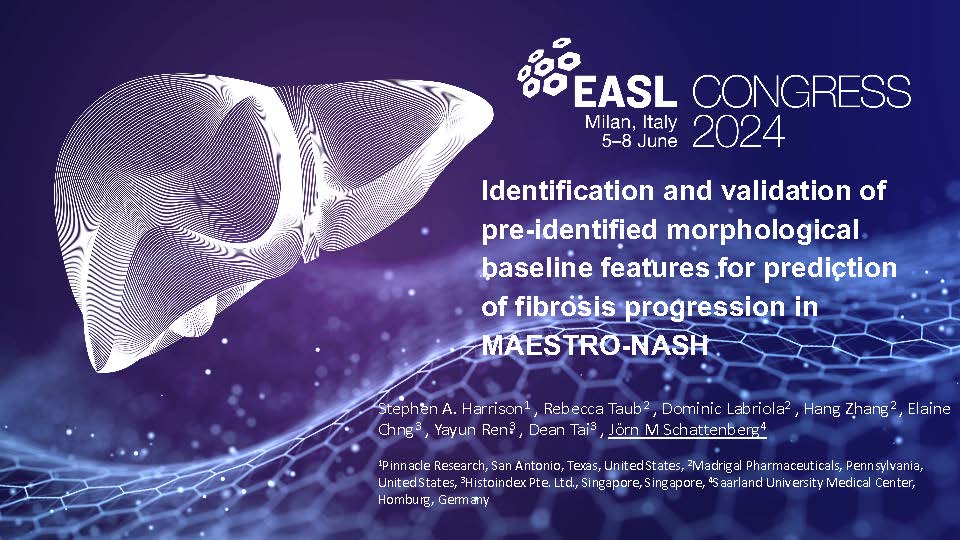Presentation ID: OS-124, EASL Congress 2024
ABSTRACT
Authors: Stephen A. Harrison1, Rebecca Taub2, Dominic Labriola2, Hang Zhang2, Elaine Chng3, Yayun Ren3, Dean Tai3, Jörn M Schattenberg4
1. Pinnacle Research, San Antonio, Texas, United States
2. Madrigal Pharmaceuticals, Pennsylvania, United States
3. Histoindex Pte. Ltd., Singapore, Singapore
4. Saarland University Medical Center, Homburg, Germany
Background and Aims: Fibrosis staging remains the pinnacle predictor of clinical outcomes in metabolic-associated steatohepatitis (MASH) clinical trials, with liver biopsies as the gold standard. However, the ability to reflect dynamic fibrotic changes using ordinal scores in interventional trials remains contentious. Various non-invasive tests (NITs) have been developed but without success in replacing biopsies thus far. qFibrosis, an AI-driven fibrosis assessment methodology, has identified specific fibrotic features potentially more predictive of clinical outcomes than ordinal stages and the aim is to validate whether these pre-identified fibrotic features can distinguish fibrosis progressors in MAESTRO-NASH. MAESTRO-NASH is an ongoing 54-month phase 3 study which achieved NASH resolution and fibrosis reduction endpoints.
Method: Based on sample availability at baseline, 845 patients had qFibrosis assessment and corresponding selected NITs (VCTE, MRE, ProC3, AST, GGT and platelets), except for MRE where there were only 495 patients. 30 fibrosis features previously identified from SteatoSITE are used in this analysis and Spearman correlation against pathologist scores. Using univariate analyses and random forest model with baseline fibrosis stage as the outcome, 6 fibrosis features (5 from periportal region, 1 from zone 2) were chosen for exploration with clinical data and subsequent validation.
Results: Correlations of NITs with pathologist scores were modest, with MRE exhibiting the highest correlation (0.489), followed by VCTE (0.309). Against the NITs, these 6 fibrosis features showed varying degrees of correlation, albeit generally mediocre (0.05 ~ 0.46). Notably, the feature from zone 2 (number of short strings) exhibited a negative correlation (-0.07 ~ -0.324), while the rest showed positive correlation. MRE and VCTE correlations with these 6 features aligned closely with pathologist scores, ranging from 0.393 to 0.464 with MRE and 0.233 to 0.342 with VCTE, suggesting nuanced fibrosis progression markers. Note that the correlation of zone 2 fibrosis feature to MRE and VCTE are -0.324 and -0.255, respectively.
Conclusion: Using pre-identified fibrosis features from SteatoSITE, which is an event-rich resource containing clinical and pathological data from MAFLD 940 cases, we validated them with MAESTRO- NASH for predicting fibrosis progression. The identification of negatively correlating features underscores the complexity of fibrosis progression markers. The findings argue against the sufficiency of NITs for predicting fibrosis progression based solely on fibrosis stages or specific fibrosis features. This highlights the necessity for a composite NIT approach, incorporating both positively and negatively correlating fibrosis features. Confirmation of clinical significance is necessary with month 54 biopsies and eventual clinical outcomes.

